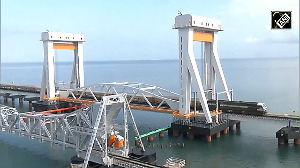In the media-surcharged atmosphere surrounding the Budget, commentators and gurus are asked to comment on the impact of the budget on various sectors. Of these, infrastructure features as a key sector where reactions are sought.
And this led me to ask a rather innocent question to Bidisha Ganguly -- the economist who handles CII's infrastructure secretariat, "How relevant is the Budget nowadays to the overall infrastructure sector?" Bidisha, in her usual diligent style, did a quick dive into figures and content. Without too much difficulty, the conclusion emerged that on financial outlays, the budget is losing relevance for new projects in the sector, but on policy and direction-setting, it continues to be impactful.
To come straight to the point on outlays, the table shows that against the country's requirement of $100 million per annum (as per the 11th Five-Year Plan), the Union Budget is able to provide only about 5-6 per cent of the requirement in 2008-09. How does this 5-6 per cent come about?
An examination of Budget documents makes it clear very quickly that it is quite difficult to separate the project wheat from the developmental and administrative chaff in terms of outlays and allocations.
So assumptions have to be made. And the assumption has been made that, overall, 33 per cent of the allocations find their way into real-time infrastructure project investments. Is this assumption defensible? Consider the following:
- Budgetary outlays are not necessarily consumed in the same fiscal year. The interplay of previous carry-overs and unutlilised current year allocations are not easy to decipher from the budget documents in terms of hard project investments on the ground.
And in the infrastructure space, spending for any project, initiative or programme gets into more than one year. Also, in the absence of an "Outcomes Budget" for the infrastructure sector, only intelligent guess-work is available. - Out of the total Plan spending of Rs 200 crore (Rs 2 billion) of the civil aviation ministry, only Rs 45 crore (Rs 450 million) is budgetary support to the Airports Authority of India for the upgradation of airports. The rest is establishment-related expenditure.
- The Budget's nomenclature of Plan versus non-Plan is not a reliable guide, and moreover, each ministry classifies investment expenditure under different heads.
- Over 60 per cent of the Plan spending mentioned in the table is by the rural development ministry. While we are all for the development of infrastructure in rural areas, one has to be careful in attributing this entire amount to infrastructure-related spending.
For example, about half of the rural development ministry's Plan allocation is for rural employment programmes such as the National Rural Employment Guarantee scheme, which cannot be counted as infrastructure spending. At the same time, Plan spending includes spending on programmes such as the Pradhan Mantri Gram Sadak Yojana, which is a major effort related to building roads in rural areas and should certainly be counted as infrastructure spending. The actual amount spent is a separate story. - Sceptics would, in fact, further argue that since only a well-known percentage of the amount spent actually reaches its intended destination, the budgetary outlays for clear projects under implementation stand further diminished.
Now, let us train our sights on the Budget's role in setting out major policy initiatives and in direction-setting. Here, the government's record has been more impressive, as major initiatives have been undertaken either to focus the government's direct spending on infrastructure (for example, Bharat Nirman) or to incentivise spending by the private sector (for example, viability gap funding).
Here is a quick recap of the Union Budget's role in direction-setting across the last five years.
2004-05
- Setting-up the Viability Gap Funding Mechanism.
- Prioritising PPPs as a preferred route.
2005-06
2006-07
2007-08
- Rupee corpus for project development under PPP mode.
- Examination of the idea of using forex reserves for infrastructure.
- Setting up the Deepak Parekh Committee for recommendations on long-term funds for infrastructure.
2008-09
As is evident, the Union Budget continues to be the annual platform from which new directions and ideas are unleashed on India. It may well be said that it is the policy tail that is increasingly wagging the infrastructure dog -- and maybe it is the right thing for the nation too!
The author is the Chairman of Feedback Ventures. He is also the Co-Chairman of CII's National Council on Infrastructure. The views expressed are personal







 © 2025
© 2025